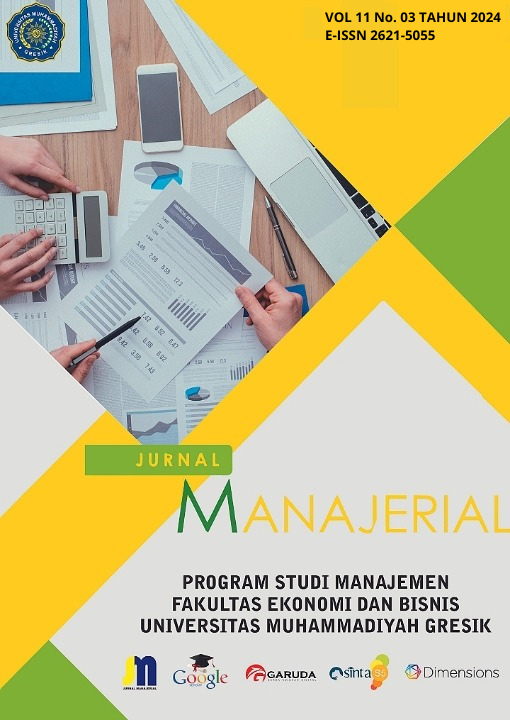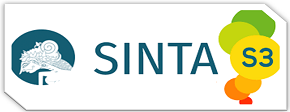Impact of Techno Overload Work Performance and Work Engagement as Intervening Variables in Semarang City SMEs
DOI:
https://doi.org/10.30587/jurnalmanajerial.v11i03.7630Keywords:
Labor, SMEs, Techno-Overload, Work Engagement, Work PerformanceAbstract
Background – Stress caused by technology overload in the workplace is one of the main factors leading to workplace stress as well as the demand for continuous improvement in work performance which can eventually lead to feelings of pressure and work overload.
Aim - This study is to analyze the impact of Techno-Overload on Work Performance with Work Engagement as an Intervening Variable on MSME Workforce in Semarang City.
Design / methodology / approach – The method used in this research is survey methodology and respondents in the SMEs workforce in Semarang, Central Java, Indonesia. SMEs in the Food & Beverage, Handicrafts, Fashion/Clothing, Retail/Minimarket, Services, and Other sectors were sampled because the workforce requires technostress-related treatment related to the types of disorders in the workforce and organizational losses, such as fatigue, dissatisfaction, anxiety, and decreased productivity. To achieve the objectives of this study, researchers involved 315 workers from 6 sectors and distributed them to SMEs in Semarang City.
Findings – The results of this study techno-overload as a technostress variable have a positive relationship to work performance. However, this study shows that work engagement has a significant influence in influencing work performance but the role of work engagement has no influence in mediating technological overload on work performance. This research is to provide an understanding of technostress that has a negative impact on MSMEs so that the workforce is able to take steps to overcome it and theoretically this research can be a benefit for further research.
Conclusion - Low techno-overload in SMEs in Semarang City can improve workforce performance. The higher work engagement and the lower techno- overload in the workforce of SMEs in Semarang City can improve workforce performance
Research implication – This research is to provide an understanding of technostress that has a negative impact on SMEs so that the workforce is able to take steps to overcome it and theoretically this research can be a benefit for further research.
Limitations - This research solely concentrates on one primary stress variable, techno-overload, because this variable significantly affects workers within the research context. There are still many research variables that could be explored regarding the phenomenon of technostress affecting job performance. Another limitation of this study is that the researchers only conducted the study in one city.
References
Anwar, N. F. (2024). Pengaruh Innovation Dan Job Crafting Yang Dimediasi. 11.
Azhad, M. N., & Anggraeni, Li. (2022). Manajemen Talenta Dan Pengembanag Karier Pengaruhnya Terhadap Kinerja Karyawan. Jurnal Manajerial, 9(03), 338.
https://doi.org/10.30587/jurnalmanajerial.v9i03.4181
Bakker, A. B., Albrecht, S. L., & Leiter, M. P. (2011). Key questions regarding work engagement. European Journal of Work and Organizational Psychology, 20(1), 4–28.
https://doi.org/10.1080/1359432X.2010.485352
Bakker, A. B., & Demerouti, E. (2017). Job demands-resources theory: Taking stock and looking forward. Journal of Occupational Health Psychology, 22(3), 273–285.
https://doi.org/10.1037/ocp0000056
Borst, R. T. (2018). Comparing Work Engagement in People-Changing and People-Processing Service Providers: A Mediation Model With Red Tape, Autonomy, Dimensions of PSM, and Performance. Public Personnel Management, 47(3), 287–313.
https://doi.org/10.1177/0091026018770225
Budhiraja, S. (2019). Organizational readiness for change: an inherent concern for Indian small and medium enterprises (SMEs). Development and Learning in Organizations, 33(2), 4–7. https://doi.org/10.1108/DLO-09-2018-0118
Data UMKM Kota Semarang 2023. (n.d.).
Fernández-Fernández, M., Martínez-Navalón, J. G., Gelashvili, V., & Román, C. P. (2023). The impact of teleworking technostress on satisfaction, anxiety and performance. Heliyon, 9(6). https://doi.org/10.1016/j.heliyon.2023.e17201
Hair, J. F., Risher, J. J., Sarstedt, M., & Ringle, C. M. (2019). When to use and how to report the results of PLS-SEM. In European Business Review (Vol. 31, Issue 1, pp. 2–24). Emerald Group Publishing Ltd. https://doi.org/10.1108/EBR-11-2018-0203
Hung, W. H., Chen, K., & Lin, C. P. (2015). Does the proactive personality mitigate the adverse effect of technostress on productivity in the mobile environment? Telematics and Informatics, 32(1), 143–157. https://doi.org/10.1016/j.tele.2014.06.002
Jena, R. K. (2015). Technostress in ICT enabled collaborative learning environment: An empirical study among Indian academician. Computers in Human Behavior, 51, 1116–1123. https://doi.org/10.1016/j.chb.2015.03.020
Karatepe, O. M. (2013). High-performance work practices and hotel employee performance: The mediation of work engagement. International Journal of Hospitality Management, 32(1), 132–140. https://doi.org/10.1016/j.ijhm.2012.05.003
Karr-Wisniewski, P., & Lu, Y. (2010). When more is too much: Operationalizing technology overload and exploring its impact on knowledge worker productivity. Computers in Human Behavior, 26(5), 1061–1072. https://doi.org/10.1016/j.chb.2010.03.008
Kim, W., Kolb, J. A., & Kim, T. (2013). The Relationship Between Work Engagement and Performance: A Review of Empirical Literature and a Proposed Research Agenda. In Human Resource Development Review (Vol. 12, Issue 3, pp. 248–276).
https://doi.org/10.1177/1534484312461635
La Torre, G., Esposito, A., Sciarra, I., & Chiappetta, M. (2019). Definition, symptoms and risk of techno-stress: a systematic review. In International Archives of Occupational and Environmental Health (Vol. 92, Issue 1, pp. 13–35). Springer Verlag.
https://doi.org/10.1007/s00420-018-1352-1
Lebrón, M., Tabak, F., Shkoler, O., & Rabenu, E. (2018). Counterproductive Work Behaviors toward Organization and Leader-Member Exchange: The Mediating Roles of Emotional Exhaustion and Work Engagement. Organization Management Journal, 15(4), 159–173. https://doi.org/10.1080/15416518.2018.1528857
Li, L., & Wang, X. (2021). Technostress inhibitors and creators and their impacts on university teachers’ work performance in higher education. Cognition, Technology and Work, 23(2), 315–330. https://doi.org/10.1007/s10111-020-00625-0
Maier, C., Laumer, S., Eckhardt, A., & Weitzel, T. (2015). Giving too much social support: Social overload on social networking sites. European Journal of Information Systems, 24(5), 447–464. https://doi.org/10.1057/ejis.2014.3
Marchiori, D. M., Mainardes, E. W., & Rodrigues, R. G. (2019). Do Individual Characteristics Influence the Types of Technostress Reported by Workers? International Journal of Human-Computer Interaction, 35(3), 218–230.
https://doi.org/10.1080/10447318.2018.1449713
Nisafani, A. S., Kiely, G., & Mahony, C. (2020). Workers’ technostress: a review of its causes, strains, inhibitors, and impacts. Journal of Decision Systems, 29(sup1), 243–258. https://doi.org/10.1080/12460125.2020.1796286
Pansini, M., Buonomo, I., De Vincenzi, C., Ferrara, B., & Benevene, P. (2023). Positioning Technostress in the JD-R Model Perspective: A Systematic Literature Review. In Healthcare (Switzerland) (Vol. 11, Issue 3). MDPI.
https://doi.org/10.3390/healthcare11030446
Picazo Rodríguez, B., Verdú-Jover, A. J., Estrada-Cruz, M., & Gomez-Gras, J. M. (2023). Does digital transformation increase firms’ productivity perception? The role of technostress and work engagement. European Journal of Management and Business Economics. https://doi.org/10.1108/EJMBE-06-2022-0177
Salmela-Aro, K., Rantanen, J., Hyvönen, K., Tilleman, K., & Feldt, T. (2011). Bergen Burnout Inventory: Reliability and validity among Finnish and Estonian managers. International Archives of Occupational and Environmental Health, 84(6), 635–645. https://doi.org/10.1007/s00420-010-0594-3
Tarafdar, M., Pullins, E. B., & Ragu-Nathan, T. S. (2015). Technostress: Negative effect on performance and possible mitigations. Information Systems Journal, 25(2), 103–132. https://doi.org/10.1111/isj.12042
Tarafdar, M., Tu, Q., & Ragu-Nathan, T. (2010). Impact of technostress on end-user satisfaction and performance. Journal of Management Information Systems, 27(3), 303–334. https://doi.org/10.2753/MIS0742-1222270311
Yener, S., Arslan, A., & Kilinç, S. (2021). The moderating roles of technological self-efficacy and time management in the technostress and employee performance relationship through burnout. Information Technology and People, 34(7), 1890–1919. https://doi.org/10.1108/ITP-09-2019-0462
Yin, P., Ou, C. X. J., Davison, R. M., & Wu, J. (2018). Coping with mobile technology overload in the workplace. Internet Research, 28(5), 1189–1212. https://doi.org/10.1108/IntR-01-2017-0016
Yu, L., Cao, X., Liu, Z., & Wang, J. (2018). Excessive social media use at work: Exploring the effects of social media overload on job performance. Information Technology and People, 31(6), 1091–1112. https://doi.org/10.1108/ITP-10-2016-0237






























 P-ISSN: 2354-8592 __ E-ISSN: 2621-5055
P-ISSN: 2354-8592 __ E-ISSN: 2621-5055 
